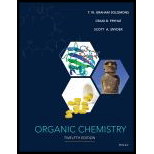
Interpretation:
The synthesis of 1-butyne from the given reactants is to be shown.
Concept introduction:
Electrophiles are electron-deficient species, which has positive or partially positive charge. Lewis acids are electrophiles, which accept electron pair.
Nucleophiles are electron-rich species, which has negative or partially negative charge. Lewis bases are nucleophiles, which donate electron pair.
Substitution reaction: A reaction in which one of the hydrogen atoms of a hydrocarbon or a
Elimination reaction: A reaction in which two substituent groups are detached and a double bond is formed is called elimination reaction.
Addition reaction: It is the reaction in which unsaturated bonds are converted to saturated molecules by the addition of molecules.
The reaction in which the halide group and hydrogen group are removed to form
The reaction in which hydrogen is added to the compound in the presence of catalyst is known as hydrogenation.
The number of moles of hydrogen absorbed will be equal to the number of double bonds.
Sodium amide is a strong base, which helps in the removal of terminal hydrogen of
Want to see the full answer?
Check out a sample textbook solution
Chapter 8 Solutions
EBK ORGANIC CHEMISTRY
- Using cyclohexane as your starting material, show how you would synthesize each of the following compounds. (Onceyou have shown how to synthesize a compound, you may use it as the starting material in any later parts of this problem.)(a) bromocyclohexane (b) cyclohexene (c) ethoxycyclohexane(d) 3-bromocyclohex-1-ene (e) cyclohexa-1,3-diene (f) cyclohexanolarrow_forwardUsing cyclohexane as your starting material, show how you would synthesize each of the following compounds. (Onceyou have shown how to synthesize a compound, you may use it as the starting material in any later parts of this problem.)(a) bromocyclohexane (b) cyclohexene (c) ethoxycyclohexane(d) 3-bromocyclohex-1-enearrow_forwardWhich compounds can be prepared in high yield by halogenation of an alkane? (a) 2-Chloropentane (b) Chlorocyclopentane (c) 2-Bromo-2-methylheptane (d) (R)-2-Bromo-3-methylbutane (e) 2-Bromo-2,4-trimethylpentane (f) Iodoethanearrow_forward
- Show how you would synthesize the following compounds, starting with acetylene and any compounds containing nomore than four carbon atoms.(a) hex-1-yne (b) hex-2-yne(c) cis-hex-2-ene (d) trans-hex-2-enearrow_forwardUsing cyclooctyne as your starting material, show how you would synthesize the following compounds. (Once you haveshown how to synthesize a compound, you may use it as the starting material in any later parts of this problem.)(a) cis-cyclooctene (b) cyclooctane (c) trans-1,2-dibromocyclooctane(d) cyclooctanone (e) 1,1-dibromocyclooctane (f) 3-bromocyclooctene(g) cyclooctane-1,2-dionearrow_forwardSpecify reagents suitable for converting 3-ethyl-2-pentene to each of the following: (a) 2,3-Dibromo-3-ethylpentane (b) 3-Chloro-3-ethylpentane (c) 3-Ethyl-3-pentanol (d) 3-Ethyl-2-pentanol (e) 2,3-Epoxy-3-ethylpentane (f) 3-Ethylpentanearrow_forward
- Show how free-radical halogenation might be used to synthesize the followingcompounds. In each case, explain why we expect to get a single major product.(a) 1-chloro-2,2-dimethylpropane (neopentyl chloride)(b) 2-bromo-2-methylbutanearrow_forwardUsing cyclooctyne as your starting material, show how you would synthesize the following compounds. (Once you haveshown how to synthesize a compound, you may use it as the starting material in any later parts of this problem.)(a) cis-cyclooctene (b) cyclooctane (c) trans-1,2-dibromocyclooctanearrow_forwardReaction of this bicycloalkene with bromine in carbon tetrachloride gives a trans dibro- mide. In both (a) and (b), the bromine atoms are trans to each other. However, only one of these products is formed. CH3 CH3 CH3 Br Br CH,Cl, + Br2 or Br Br (a) (b) Which trans dibromide is formed? How do you account for the fact that it is formed to the exclusion of the other trans dibromide?arrow_forward
- Predict the major products of the following reactions, including stereochemistry.(a) cyclohexene + KMnO4>H2O (cold, dilute)(b) cyclohexene + peroxyacetic acid in waterarrow_forwardFor each alkane, which mono brominated derivatives could you form in good yield by free-radical bromination?(a) cyclopentane (b) methylcyclopentane(c) 2-methylpentane (d) 2,2,3,3-tetramethylbutanearrow_forwardShow how you would synthesize the following compounds, starting with acetylene and any compounds containing nomore than four carbon atoms.(a) hex-1-yne (b) hex-2-yne(c) cis-hex-2-ene (d) trans-hex-2-ene(e) 1,1-dibromohexane (f) 2,2-dibromohexane(g) pentanal, CH3CH2CH2CH2CHO (h) pentan-2-one, CH3¬CO¬CH2CH2CH3arrow_forward
 ChemistryChemistryISBN:9781305957404Author:Steven S. Zumdahl, Susan A. Zumdahl, Donald J. DeCostePublisher:Cengage Learning
ChemistryChemistryISBN:9781305957404Author:Steven S. Zumdahl, Susan A. Zumdahl, Donald J. DeCostePublisher:Cengage Learning ChemistryChemistryISBN:9781259911156Author:Raymond Chang Dr., Jason Overby ProfessorPublisher:McGraw-Hill Education
ChemistryChemistryISBN:9781259911156Author:Raymond Chang Dr., Jason Overby ProfessorPublisher:McGraw-Hill Education Principles of Instrumental AnalysisChemistryISBN:9781305577213Author:Douglas A. Skoog, F. James Holler, Stanley R. CrouchPublisher:Cengage Learning
Principles of Instrumental AnalysisChemistryISBN:9781305577213Author:Douglas A. Skoog, F. James Holler, Stanley R. CrouchPublisher:Cengage Learning Organic ChemistryChemistryISBN:9780078021558Author:Janice Gorzynski Smith Dr.Publisher:McGraw-Hill Education
Organic ChemistryChemistryISBN:9780078021558Author:Janice Gorzynski Smith Dr.Publisher:McGraw-Hill Education Chemistry: Principles and ReactionsChemistryISBN:9781305079373Author:William L. Masterton, Cecile N. HurleyPublisher:Cengage Learning
Chemistry: Principles and ReactionsChemistryISBN:9781305079373Author:William L. Masterton, Cecile N. HurleyPublisher:Cengage Learning Elementary Principles of Chemical Processes, Bind...ChemistryISBN:9781118431221Author:Richard M. Felder, Ronald W. Rousseau, Lisa G. BullardPublisher:WILEY
Elementary Principles of Chemical Processes, Bind...ChemistryISBN:9781118431221Author:Richard M. Felder, Ronald W. Rousseau, Lisa G. BullardPublisher:WILEY





